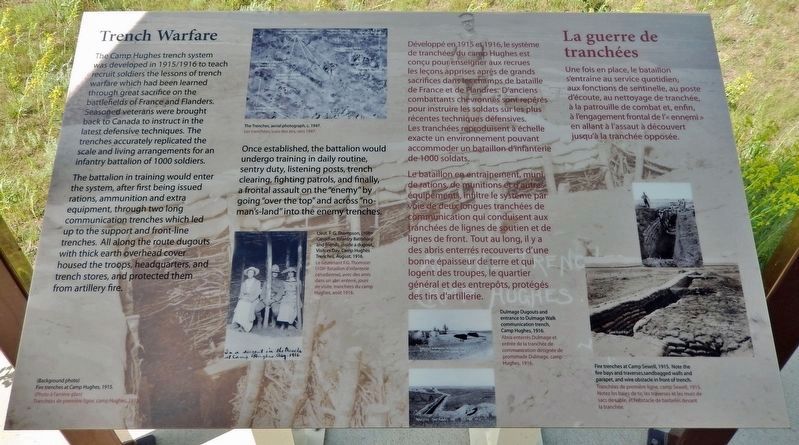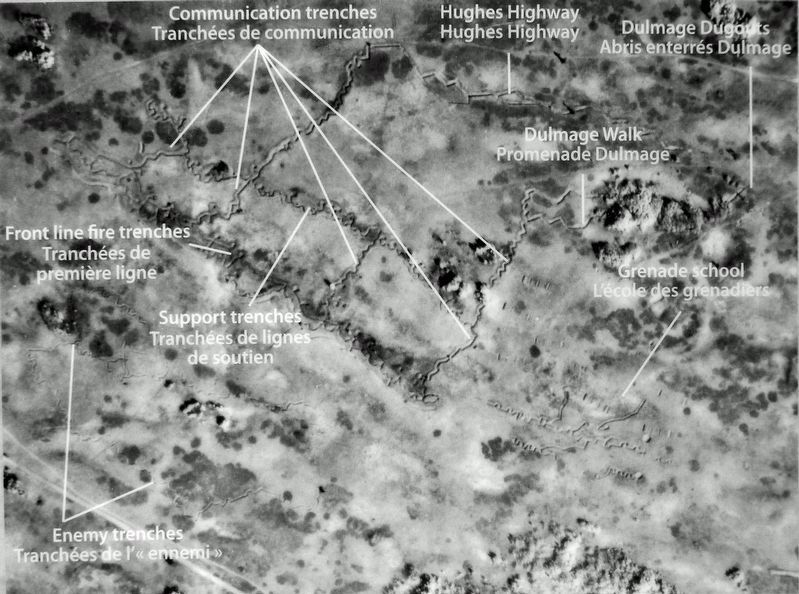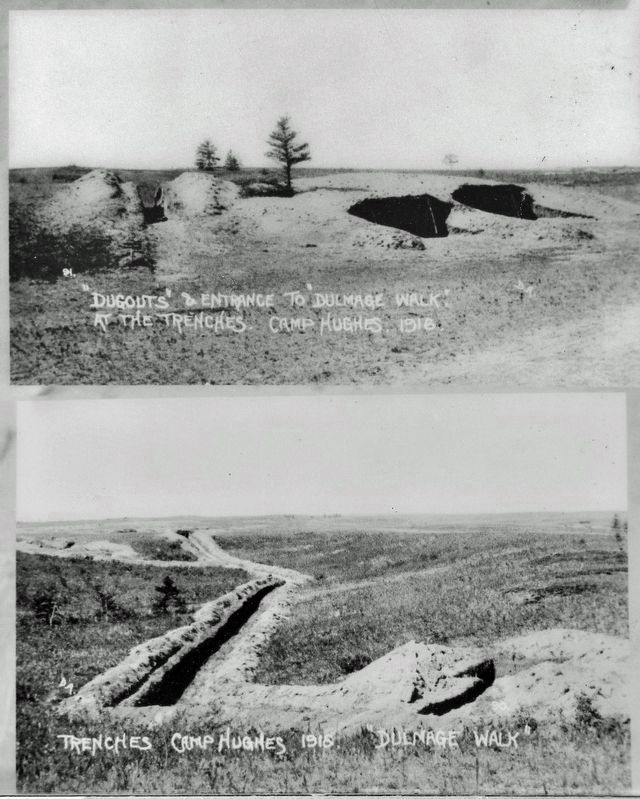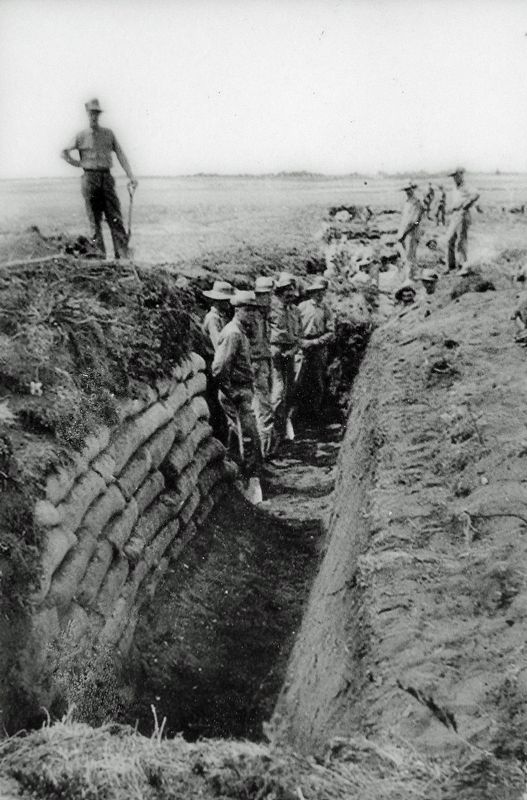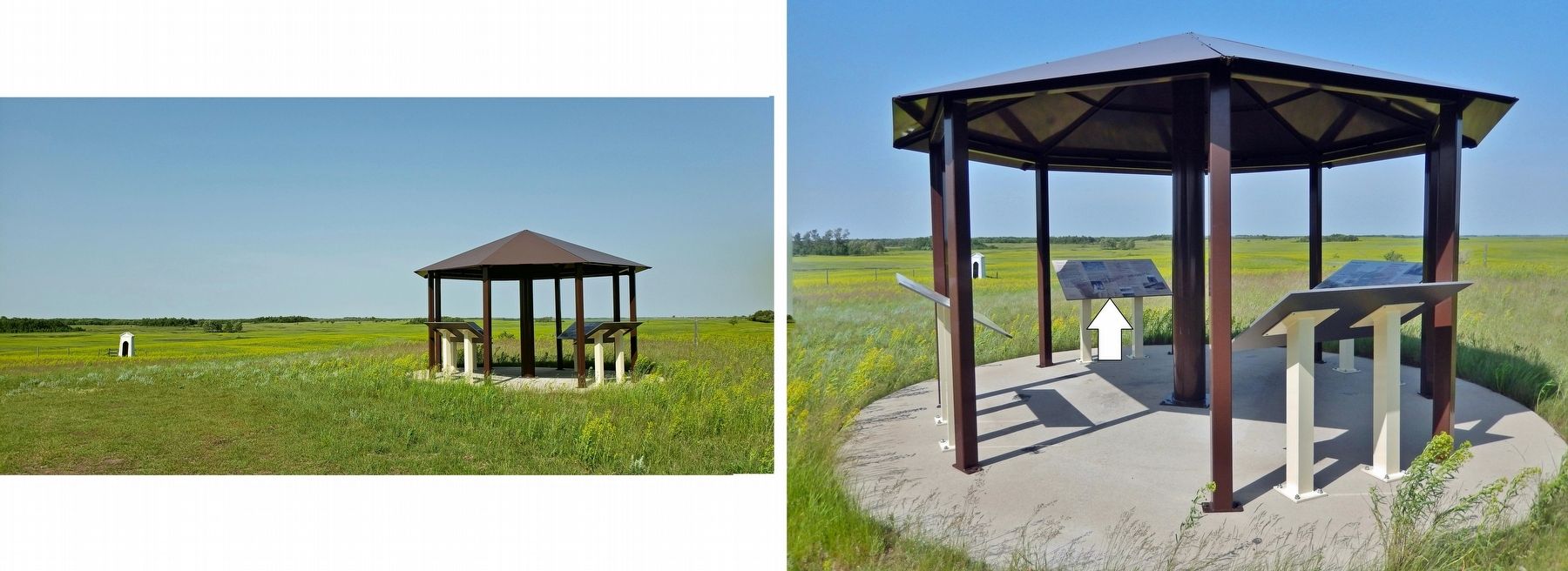Camp Hughes in North Cypress – Langford Municipality, Manitoba — Canada’s Prairie Region (North America)
Trench Warfare / La guerre de tranchées
The battalion in training would enter the system, after first being issued rations, ammunition and extra equipment, through two long communication trenches which led up to the support and front-line trenches. All along the route dugouts with thick earth overhead cover housed the troops, headquarters, and trench stores, and protected them from artillery fire.
Once established, the battalion would undergo training in daily routine, sentry duty, listening posts, trench clearing, fighting patrols, and finally, a frontal assault on the "enemy" by going "over the top" and across "no-man's-land" into the enemy trenches.
(Background photo)
Fire trenches at Camp Hughes, 1915.
Le bataillon en entraînement, muni de rations, de munitions et d'autres équipements, infiltre le système par voie de deux longues tranchées de communication qui conduisent aux tranchées de lignes de soutien et de lignes de front. Tout au long, il y a des abris enterrés recouverts d'une bonne épaisseur de terre et qui logent des troupes, le quartier général et des entrepôts, protégés des tirs d'artillerie.
Une fois en place, le bataillon s'entraîne au service quotidien, aux fonctions de sentinelle, au poste d'écoute, au nettoyage de tranchée, à la patrouille de combat et, enfin, à l'engagement frontal de l'« ennemi » en allant à l'assaut à découvert jusqu'à la tranchée opposée.
(Photo à l'arrière-plan)
Tranchées de première ligne, camp Hughes, 1915
Topics. This historical marker is listed in these topic lists: Education • Patriots & Patriotism • War, World I. A significant historical year for this entry is 1915.
Location.
49° 52.815′ N, 99° 33.447′ W. Marker is in Camp Hughes, Manitoba, in North Cypress – Langford Municipality. Marker can be reached from Camp Hughes Road (Road 91 W) 1.6 kilometers south of Provincial Road 351. Marker is located in the Camp Hughes National Historic Site interpretive kiosk, just west of the Camp Hughes Cemetery. Touch for map. Marker is in this post office area: Camp Hughes MB R0K 2A0, Canada. Touch for directions.
Other nearby markers. At least 8 other markers are within walking distance of this marker. Training For War / L'entraînement de guerre (here, next to this marker); Camp Hughes National Historic Site of Canada / Le camp Hughes Lieu historique national du Canada (here, next to this marker); Camp Life / La vie de camp (here, next to this marker); Camp Hughes (a few steps from this marker); Camp Hughes / Le Camp Hughes (a few steps from this marker); The Hospital / L'hôpital (approx. 0.4 kilometers away); Camp Hughes — Overview / Tour d'horizon du Camp Hughes (approx. 0.6 kilometers away); The Soldier's Recreation / Les moments de loisir des soldats (approx. 0.6 kilometers away). Touch for a list and map of all markers in Camp Hughes.
Related markers. Click here for a list of markers that are related to this marker. Camp Hughes National Historic Site
Also see . . .
1. Trench Warfare.
World War I was a war of trenches. Inside a trench, all that is visible is(Submitted on March 24, 2023, by Cosmos Mariner of Cape Canaveral, Florida.)just a few feet on either side, ending at the trench walls in front and back, with a patch of leaden sky visible above. Trenches in WWI were constructed with sandbags, wooden planks, woven sticks, tangled barbed wire or even just stinking mud. Both sides would launch attacks against the enemy’s trench lines, attacks that resulted in horrific casualties.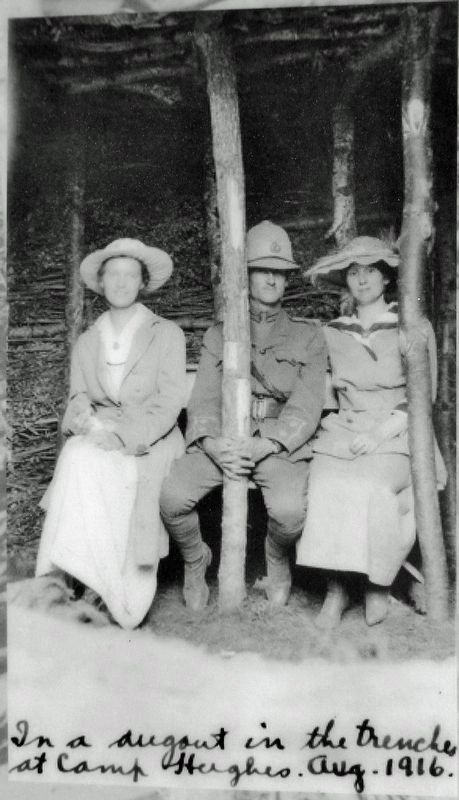 3. Marker detail: Visitors Day, August 1916 / Jours de visite, août 1916Lieut. F. G. Thompson, (108th Canadian Infantry Battalion) and friends, inside a dugout, Visitors Day, Camp Hughes Trenches, August 1916.
3. Marker detail: Visitors Day, August 1916 / Jours de visite, août 1916Lieut. F. G. Thompson, (108th Canadian Infantry Battalion) and friends, inside a dugout, Visitors Day, Camp Hughes Trenches, August 1916.————— Le lieutenant F.G. Thomson (108e Bataillon d'infanterie canadienne), avec des amis dans un abri enterré, jours de visite, tranchées du camp Hughes, août 1916.
2. Life in the Trenches of World War I.
Long, narrow trenches dug into the ground at the front, usually by the infantry soldiers who would occupy them for weeks at a time, were designed to protect World War I troops from machine-gun fire and artillery attack from the air. Trenches are most often associated with World War I, and the results of trench warfare in that conflict were hellish indeed.(Submitted on March 24, 2023, by Cosmos Mariner of Cape Canaveral, Florida.)
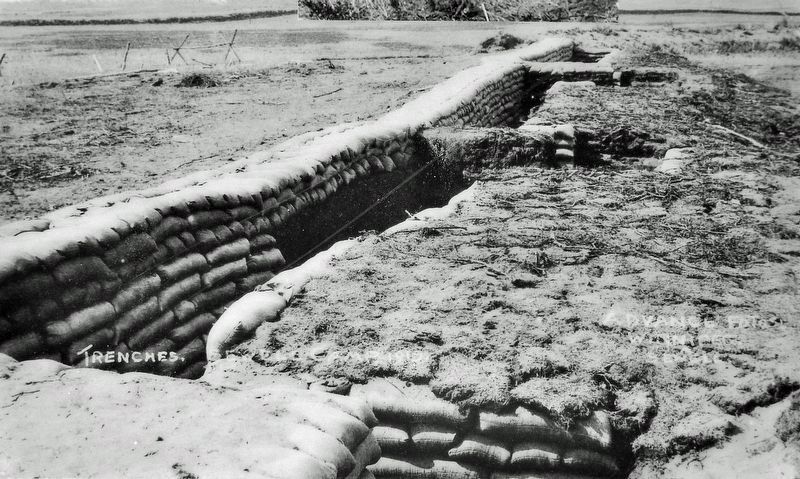
6. Marker detail: Fire trenches / Tranchées de première ligne
Fire trenches at Camp Sewell, 1915. Note the fire bays and traverses, sandbagged walls and parapet, and wire obstacle in front of trench. ————— Tranchées de première ligne, camp Sewell, 1915. Notez les baies de tir, les traverses et les murs de sacs de sable, et l'obstacle de barbelés devant la tranchée.
Credits. This page was last revised on March 24, 2023. It was originally submitted on March 23, 2023, by Cosmos Mariner of Cape Canaveral, Florida. This page has been viewed 92 times since then and 12 times this year. Photos: 1, 2, 3, 4, 5, 6, 7. submitted on March 24, 2023, by Cosmos Mariner of Cape Canaveral, Florida.
